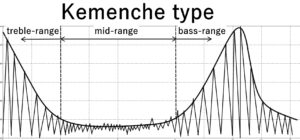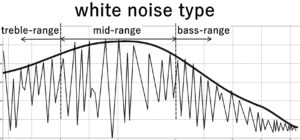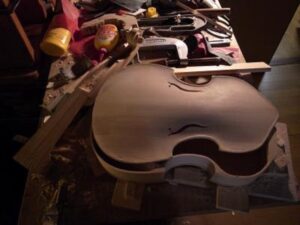In search of white noise

This is the waveform when the white noise sound source is measured with the freeware “Wave Spectra”. We can see that all frequencies are evenly included.
I want the resonance plate to be in this state as well, but how should I carve it? Most musical instruments are expected to have the following frequency distribution.

This is a state in which the treble and bass components are separated and there is no vibration component in the intermediate range that connects them. As we saw in Kemenche, a lot of small musical instruments (partial vibration, treble component) coexist. It seems that most of the ordinary violins as well as Kemenche are in this state.
How can I make the part (treble range) and the whole (bass range) blend together without any contradiction?
It seems that the range of the intermediate range can only be created by the contribution of the overall frequency distribution.
 [This is the ideal distribution.]
[This is the ideal distribution.]
Outline studies have shown that only one fixed point is allowed. This is because the treble part of the split vibration is consistently fused with the bass part only in this case.
Facts:The number of fixed points (vortices) in the phonogram is proportional to the number of split vibrations.
Think of a resonance plate that is spliced with various materials.
For example, when iron and wood are joined together to form a single plate, the fundamental frequency of iron and the fundamental frequency of wood are very different, so it cannot be made into a single resonator. This is caused by the difference in density within a piece of wood, and it is the phonogram that captures it. Physical measurements based on visual cognition never take.
hypothesis: If the fixed points of the phonogram are unified, the spectral distribution becomes a white noise type.
I don’t think I can answer this right away, but I continue the research in this direction.
It’s a little different, but I think most people have a low voice when they’re tired. This is due to the fact that the whole body is relaxed, muscle strength is weakened, and it bends, so that the treble range does not come out. Also, when we grow old, our voices become louder. Tissues throughout the body become stiff here and there, increasing the treble component. Due to the loss of systemicity, there is no bass, resulting in a dull voice.
What is the voice of a young and healthy person? What is the state of the voice that shows the white noise distribution?
Perhaps humanity is still unaware of the state.
What if the secret of the violin masterpiece is hidden around here? Phonogram research can be a new tool that can scientifically explore the hidden potential of human beings, not just the study of musical instruments and health.
When a baby hears white noise, he (or she) laughs a lot. If you can make a baby laugh by rubbing a resonator, that might be white noise!
- カテゴリー
- BLOG


